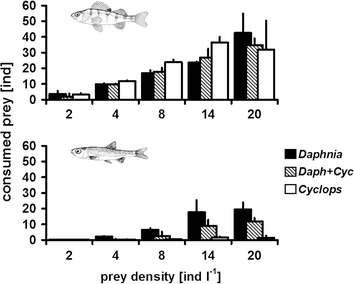 The effect of feeding behaviour on the prey capture efficiency of young-of-the-year European perch and roach was investigated in laboratory experiments using planktonic crustaceans possessing different escape abilities – Daphnia sp. and Cyclops sp. Two sets of experiments were performed. In the first set, the feeding efficiency and behaviour of 270 fish individuals were determined by stomach content analyses and video record evaluations. In the second set of experiments, analysis of attack-effort, which was evaluated as attack-distance and repeated strikes, was undertaken. Except for situations in which Daphnia was offered at high densities, the feeding efficiency of perch was significantly higher compared to roach in all other combinations of prey types and densities. Roach consumed significantly less prey compared to perch when feeding exclusively on the evasive Cyclops and when it was offered in a 1:1 ratio mixture with Daphnia. The mean swimming speed was similar in both fish species, but behavioural differences were evident during prey search and capture. Perch swam through the aquaria in short and fast movements that were interrupted by many stops. Roach exhibited rather continuous swimming that was punctuated by slowdowns instead of stops. The perch attacks were very intensive and repeated strikes occurred, particularly when feeding on evasive Cyclops. On the other hand, roach revealed strong schooling behaviour restricting the fish during inspection of the experimental aquaria. The distinct differences in feeding efficiency between perch and roach were demonstrated to be closely related to differences in their feeding behaviour. Discontinuous searching for prey, vigorous attacks, occurrence of repeated strikes and the absence of schooling increased perch prey capture efficiency, particularly when foraging on evasive copepods.
The effect of feeding behaviour on the prey capture efficiency of young-of-the-year European perch and roach was investigated in laboratory experiments using planktonic crustaceans possessing different escape abilities – Daphnia sp. and Cyclops sp. Two sets of experiments were performed. In the first set, the feeding efficiency and behaviour of 270 fish individuals were determined by stomach content analyses and video record evaluations. In the second set of experiments, analysis of attack-effort, which was evaluated as attack-distance and repeated strikes, was undertaken. Except for situations in which Daphnia was offered at high densities, the feeding efficiency of perch was significantly higher compared to roach in all other combinations of prey types and densities. Roach consumed significantly less prey compared to perch when feeding exclusively on the evasive Cyclops and when it was offered in a 1:1 ratio mixture with Daphnia. The mean swimming speed was similar in both fish species, but behavioural differences were evident during prey search and capture. Perch swam through the aquaria in short and fast movements that were interrupted by many stops. Roach exhibited rather continuous swimming that was punctuated by slowdowns instead of stops. The perch attacks were very intensive and repeated strikes occurred, particularly when feeding on evasive Cyclops. On the other hand, roach revealed strong schooling behaviour restricting the fish during inspection of the experimental aquaria. The distinct differences in feeding efficiency between perch and roach were demonstrated to be closely related to differences in their feeding behaviour. Discontinuous searching for prey, vigorous attacks, occurrence of repeated strikes and the absence of schooling increased perch prey capture efficiency, particularly when foraging on evasive copepods.
Keywords: attack-distance; Cyclops; Daphnia; feeding efficiency; repeated strikes; schooling
